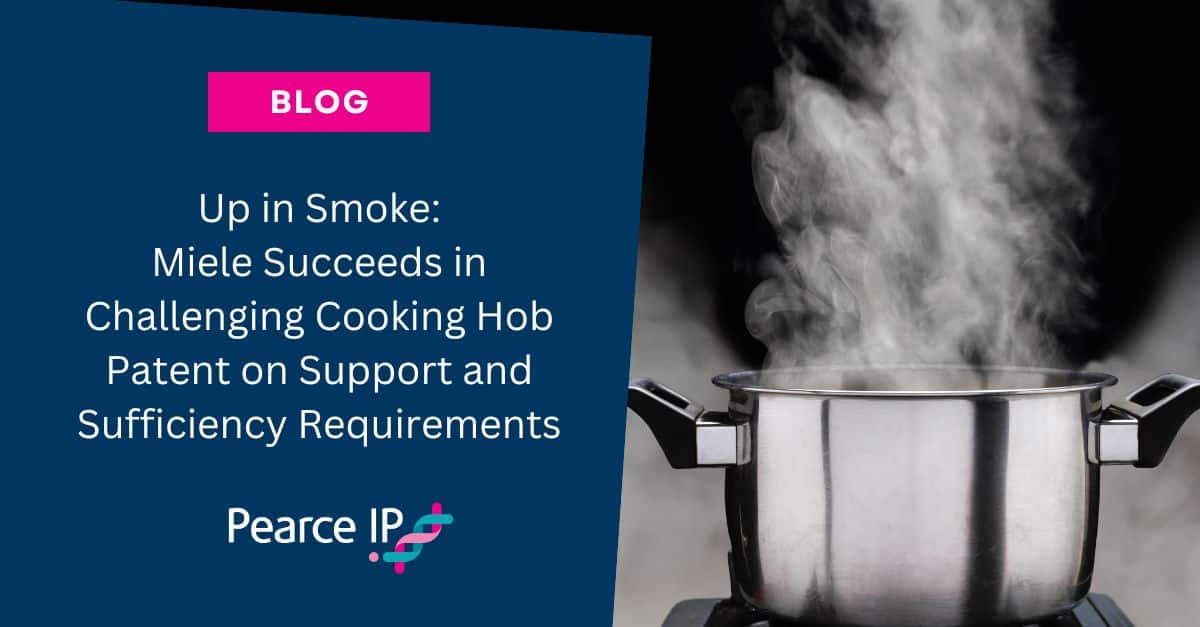| Date of decision: | 27 May 2025 |
| Body: | Federal Court of Australia |
| Adjudicator: | Justice Rofe |
Introduction
This case was a successful application by Miele, the world-renowned cooking appliance manufacturer, to revoke relevant claims of AU2012247900 entitled “Hob with central removal of cooking vapours by suction-extraction in the downward direction” (the Patent), owned by the respondent, Bruckbauer. Bruckbauer cross-claimed alleging infringement of the Patent by a number of Miele’s appliance models. Miele conceded that some, but not all, of those models would be infringing if the Patent was held to be valid. Bruckbauer failed to prove infringement on the remaining Miele models.
In finding for Miele, the Federal Court of Australia has delivered a timely reminder that amending patent claims can increase the prospect of a successful invalidity challenge, particularly given the strict requirements for support and sufficiency; and that improperly drafted amendments can also cause a loss of priority leading to novelty issues.
Background
The claimed invention related to a cook-top hob which included a device for downwardly removing cooking vapours by suction through a recess in its centre. The specification recognised prior art in which cooking vapours were removed downwardly by suction through slits at the side and back of a hob.
The judgment focused on claim 1 of the Patent, which the Court analysed using the following integer breakdown:
- 1
A hob - 1.1
with one or more cooking locations, - 1.2
which, as viewed from above, exhibits one or more recesses only in the area around its geometric centre, - 1.3
which are connected with one or more devices for removing cooking vapours through suction, - 1.3.1
wherein these devices for removing cooking vapours through suction downwardly remove the cooking vapours that arose or arise above the cooking locations by suction in a direction pointing vertically below the hob, - 1.4
wherein the bottom side of the hob is provided with a device for operating the hob and downwardly removing cooking vapours by suction that together with the hob forms an assembly unit, - 1.5
wherein the bottom side of the hob in the device as viewed downwardly sequentially in a vertical direction encompasses - 1.5.1
a housing for the heating or hob heating and control electronics, - 1.5.2
a fan housing for one, two or more radial fans, - 1.5.3
and one or more cooking vapour aspiration chambers - 1.5.3(a)
for horizontally relaying the cooking vapours toward the outside, - 1.5.3(b)
and one or more cooking vapour aspiration chambers for horizontally relaying the cooking vapours toward the outside as well as for preparing the cooking vapour stream to be vertically aspirated upwardly by means of the one, two or more radial fans provided in the fan housing and wherein the fan housing is situated above the one or more cooking vapour aspiration chambers, - 1.6
and wherein the fan housing is situated above the one or more cooking vapour aspiration chambers.
Key Issues
The key issues were:
- Whether the alleged infringing models included all the essential integers of Claim 1.
- Challenges to validity based on:
- lack of support and lack of sufficiency, including on the basis that amendments to Claim 1 had taken it beyond what was disclosed in the specification; and
- lack of novelty based on a deferred priority date caused by the amendments and disclosure in a related, foreign patent.
The support, sufficiency and infringement issues each depended at least in part on the contested construction of claim 1 of the Patent.
Consideration
Construction
Bruckbauer argued that three of the integers should be interpreted as “non-essential”, so that replacement of those integers in the allegedly infringing products with “functional equivalents” would not avoid infringement. The Court, however, referred to a number of key cases which cautioned against construing words chosen by a patentee to define its invention as including non-essential matters.1
The Court considered the proper construction of the following four integers, each relating to the construction or operation of the claimed hob. In each case, the Court preferred Miele’s construction over that of Bruckbauer:
- Integer 1.5 – “…the device as viewed downwardly sequentially in a vertical direction encompasses [various components listed]”. The Court preferred Miele’s view that the word “sequentially”, given its ordinary meaning, meant that the claim only covered the listed components when present in the order in which they were listed. Bruckbauer argued that the order was not relevant. The Court noted that on the patentee’s construction, the word “sequentially” would have no meaning.
- Integer 1.5.1 – “a housing for the heating or hob heating and control electronics”. The issue here was whether “heating electronics” included the heating hob itself, or only control electronics. The Court again accepted Miele’s position, finding that the integer required a housing including within it at least basic control electronics (including but not limited to on/off switches for heating elements and fans, fan speed) and electronics associated with the operation of the heating elements, and might include (but did not require) other components (such as the hob heating elements, the power electronics for fan motors and touch-control operating components).
- Integer 1.5.3 – “cooking vapour aspiration chambers”. The Court again sided with Miele in finding that such a chamber required a defined and enclosed volume with an inlet and an outlet from which air is sucked. That is, the chamber must have physical boundaries for negative pressure to be maintained allowing suction to occur. The Court rejected Bruckbauer’s contention that a cooking vapour aspiration chamber may be a space within walls that is not necessarily closed off or separated from other chambers, as the specification was clear that “aspiration” requires suction.
- Integer 1.5.3(b) – “one or more cooking vapour aspiration chambers…for preparing the cooking vapour stream to be vertically aspirated upwardly by means of the one, two or more radial fans…”. Once more, the Court agreed with Miele that this required the entire vapour stream, and not just a part of it, to be vertically aspirated by means of the fans.
Infringement
Infringement was only contested in respect of one of two ranges of Miele’s products. Miele succeeded in its argument that the contested range of products did not have every integer of any claim of the Patent. In particular, the Court held that:
- The relevant products had a single aspiration chamber within which was a fan housing. Therefore, they did not have the integer of a fan housing “situated above the one or more cooking vapour aspiration chambers”.
- Even if it accepted Bruckbauer’s submission that the products had two aspiration chambers (which it did not), the patent claim required the fan housing to be above both chambers, when it was only above one alleged chamber. The Court rejected Bruckbauer’s argument that a “functionally equivalent” second cooking vapour aspiration chamber above the fan housing would not avoid infringement.
- The contested Miele products were found not to prepare the entire cooking vapour stream to be vertically aspirated upwardly; some was aspirated downwardly.
Deferred Priority date
Miele argued that an amendment to the Patent in 2015, introducing a claim requiring only one fan, was not described and disclosed in the PCT application from which priority was claimed. Miele argued that the PCT application only disclosed an invention with two or more fans. Therefore, Miele asserted that the claim, so far as it related to hob assemblies with only one fan, had a priority date in 2015 being when the amendment was made, and that novelty (see further below) should be considered on the basis of this deferred priority date.
Bruckbauer argued that the PCT application, although not expressly describing an assembly with one “fan”, did disclose an assembly with “one or more devices…for removing cooking vapours via suction”.
In determining the question of priority, the Court was required to determine two key issues:
- Whether the skilled addressee would understand the “device” to be a fan; and if so
- Whether the PCT application was clear enough and complete enough for the invention using one fan to be performed by the skilled addressee.
The Court considered the way in which the term “device” was used in the PCT application and the express disclosures relating to fans, concluding that the PCT application did not use the word “device” as interchangeable with “fan”, rather it referred to a whole assembly of various components. For example, the PCT application referred to a “device” as part of the claimed assembly that incorporated two fans. Conversely, the Court found that there was no disclosure of an assembly with only one fan.
Bruckbauer sought to rely on an implicit disclosure in the PCT application of an assembly with one fan. The Court disagreed that this implication could be drawn from the PCT application, and stated that, in any case, an implication was not sufficient – the relevant question was what was disclosed by the priority document to the skilled addressee, not what might be made obvious to them by that document in light of the common general knowledge. It was impermissible to use the common general knowledge to supplement the disclosure in the specification, or to add a further feature.2
Accordingly, the Court concluded that the PCT application disclosed a different invention to the Patent. The 2015 amendments were therefore not allowable under section 102 of the Patents Act.
The Court then went on to consider whether the Patent as amended in 2015 disclosed the invention with one fan, finding that it was not disclosed. The Court considered that amended claim 1 defined more than one form of the invention, and that, pursuant to section 43(3) of the Patents Act, the claim to the invention of a hob assembly with one fan had a different priority date to the invention of a hob assembly with two or more fans, being 11 November 2015.
Novelty
Bruckbauer conceded that an assembly as claimed with two or more fans was not novel at the deferred priority date of 11 November 2015. For completeness, the Court addressed the issue of whether an assembly with one fan would have been novel at that date, finding that it was.
It was not disputed that, before 11 November 2015, a Chinese patent application derived from the same PCT application as the Patent had been published but not granted. On 16 October 2015, Bruckbauer had submitted amended claims for this application to the Chinese patent office. The Court considered that the Chinese amendments disclosed with sufficient particularity the invention the subject of claim 1 of the patent to render that claim not novel.
Bruckbauer, however, contended that the Chinese amendments were not publicly available before the deferred priority art. The Court considered in some detail the Chinese patent office rules and guidelines applicable at the relevant time as well as expert evidence given by Chinese patent attorneys. The Court held that, despite some evidence that actual practice had varied from the relevant rules and guidelines, Miele had not discharged the evidential onus of proving the October 2015 amendments were publicly available before the deferred priority date. Accordingly, Miele did not succeed on its novelty ground.
Support
The 2015 amendments included a consistory clause mirroring amended claim 1 and referring to one fan. The Court found that this was not enough to provide sufficient support for amended claim 1, saying that the mere mention in the specification of features appearing in the claim was not sufficient to provide support. The Court quoted Schering Biotech Corp’s Application3: “the word ‘support’ means more than that and requires the description to be the base which can fairly entitle the patentee to a monopoly of the width claimed”.
Sufficiency
Based on the expert evidence, the Court determined that more than routine trial and error would be required to develop a one fan configuration from the disclosure given which would enable the invention to generate sufficient suction to downwardly remove cooking vapours as required by claim 1. The claim therefore failed for lack of sufficiency.
Outcome and Implications
Miele was wholly successful in revoking the Patent on the grounds of lack of support and sufficiency. Miele’s products in respect of which infringement was contested were also held not to infringe.
The Court’s decision provides a salient reminder of some established principles, including:
- Even expert evidence is unlikely to persuade a Court that words in a patent claim (not being terms of art) do not bear their ordinary meaning.
- Patentees will generally be held to the words they have chosen for their claims and stated integers are likely to be held to be essential features of a claim.
- Support and sufficiency require more than mere mention in a specification of features of a claim.
- The risk that patent filings in another country can become relevant prior art for novelty if the Court finds that the claim as amended was not entitled to the original priority date. Although the validity challenge based on novelty failed, this was only because Miele could not definitively establish that ungranted amendments sought for a related Chinese patent application were publicly available through the Chinese patent office website before the priority date.
1Including Catnic Components Ltd v Hill & Smith Ltd [1982] RPC 183 at 242, 243; Fresenius Medical Care Australia Pty Limited v Gambro Pty Ltd [2005] FCAFC 220; (2005) 67 IPR 230 at [70]; Fisher & Paykel Healthcare Pty Ltd v Avion Engineering Pty Ltd (1991) 22 IPR 1 at 20; Nicaro Holdings Pty Ltd v Martin Engineering Co [1990] FCA 40; (1990) 16 IPR 545 at 559–60; Meat & Livestock Australia Ltd v Cargill, Inc [2018] FCA 51; (2018) 129 IPR 278 at [356].
2Icescape Ltd v Ice-World International BV [2018] EWCA Civ 2219; [2019] FSR 5 at [42].
3 Schering Biotech Corp’s Application [1993] RPC 249.
About Pearce IP
Pearce IP is a specialist firm offering intellectual property specialist lawyers and attorneys with a focus on the life sciences industries. Pearce IP and its leaders are ranked in every notable legal directory for legal, patent and trade mark excellence, including: Chambers & Partners, Legal 500, IAM Patent 1000, IAM Strategy 300, MIP IP Stars, Doyles Guide, WTR 1000, Best Lawyers, WIPR Leaders, 5 Star IP Lawyers, among others.
In 2025, Pearce IP was recognised by Australasian Lawyer and New Zealand Lawyer’s 5 Star Employer of Choice, and is the “Standout Winner” for inclusion and culture for firms with less than 100 employees. Pearce IP was awarded “IP Team of the Year” by Lawyers Weekly at the 2021 Australian Law Awards. Pearce IP is recognised by Managing IP as the only leading ANZ IP firm with a female founder, and is certified by WEConnect International as women owned.

Paul Johns
Executive, Lawyer (NZ, AU) & Trade Mark Attorney (NZ), (Head of Litigation – New Zealand)
Paul is Head of Pearce IP’s New Zealand litigation team and an IP dispute specialist with 24+ years’ experience in New Zealand and the UK. He is recognised in IAM Patent 1000, WTR1000, Chambers Asia-Pacific, and Best Lawyers. Paul serves on New Zealand’s Copyright Tribunal, is Vice Chair of the IBA’s Patent Law Subcommittee, and is a member of the Intellectual Property Society of Australia and New Zealand and NZ Intellectual Property Attorneys Inc.

Helen Macpherson
Executive, Lawyer (Head of Litigation –Australia)
Helen is a highly regarded intellectual property specialist and industry leader with more than 25 years’ experience advising on patents, plant breeder’s rights, trade marks, copyright and confidential information. She is known for her expertise in complex, high-value patent matters and leverages her technical background in biochemistry and molecular biology to work across a wide range of technologies, including inorganic, organic, physical and process chemistry, biochemistry, biotechnology (including genetics, molecular biology and virology), and physics. Helen is an active member of the Intellectual Property Committee of the Law Council of Australia and the Intellectual Property Society of Australia and New Zealand.

Nathan Kan
Lawyer
Nathan is a lawyer specialising in life sciences, providing legal advice and litigation support across intellectual property and commercial disputes. He is passionate about the intersection of law and science, and during his time with the Science and Technology Law Association at the University of Melbourne, he helped lead events, workshops and publications across STEM fields including life sciences, AI and digital transformation.

